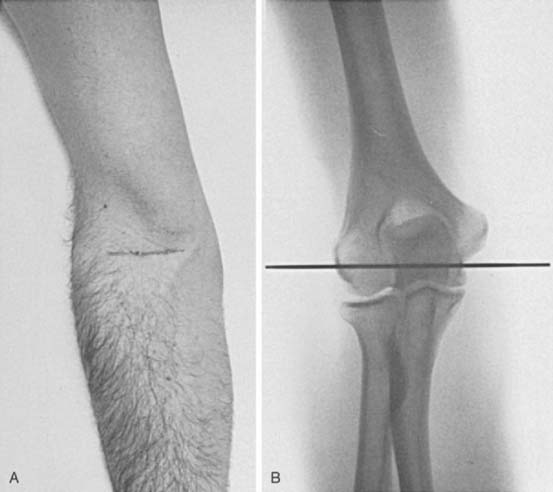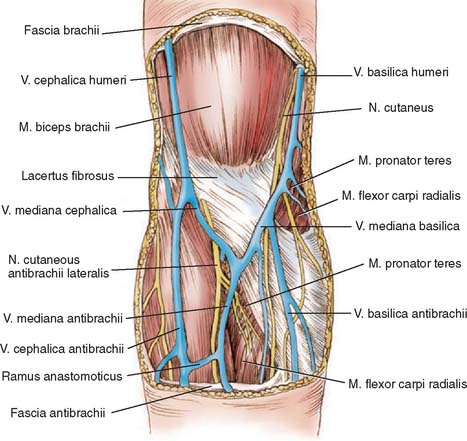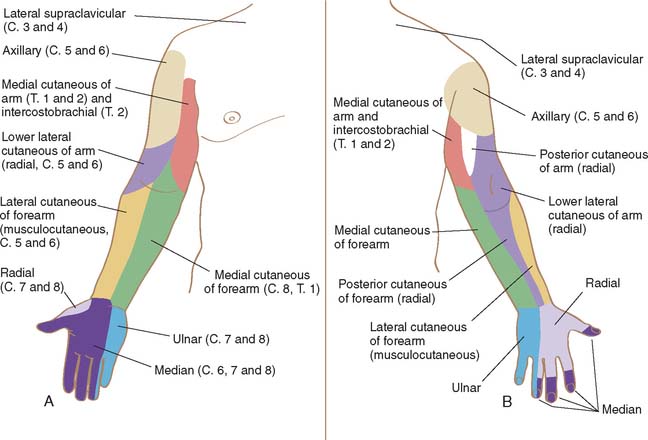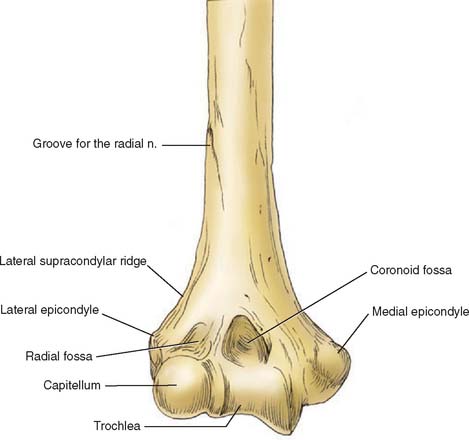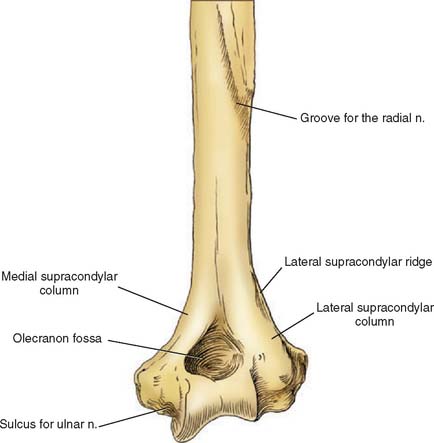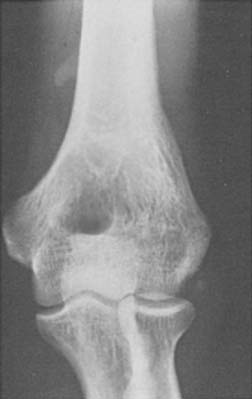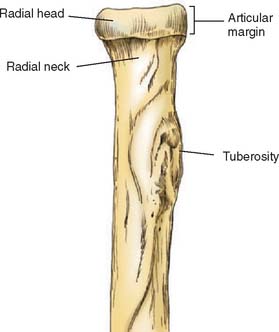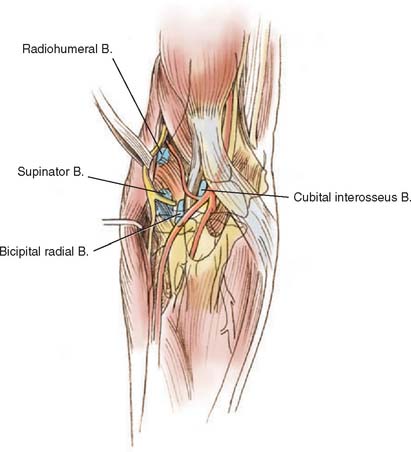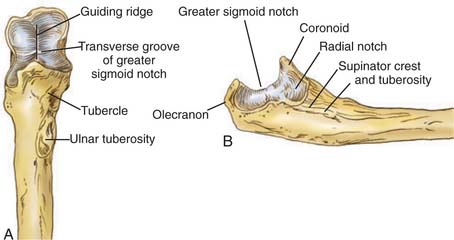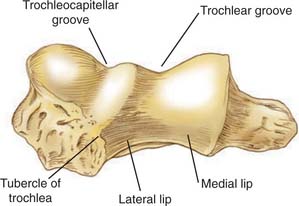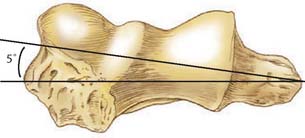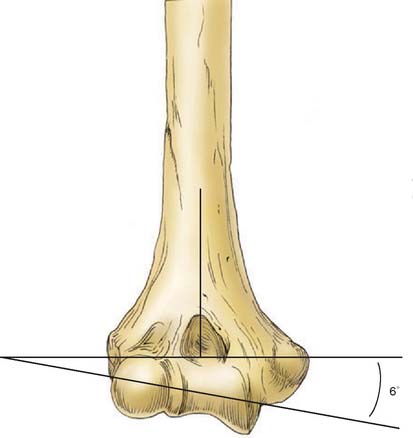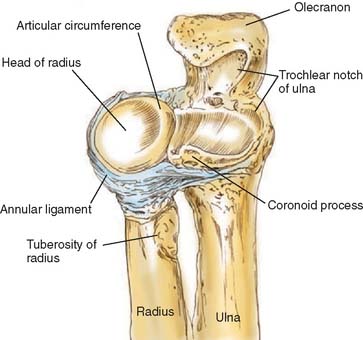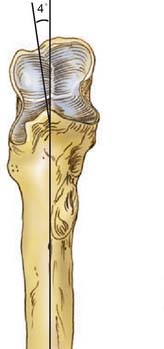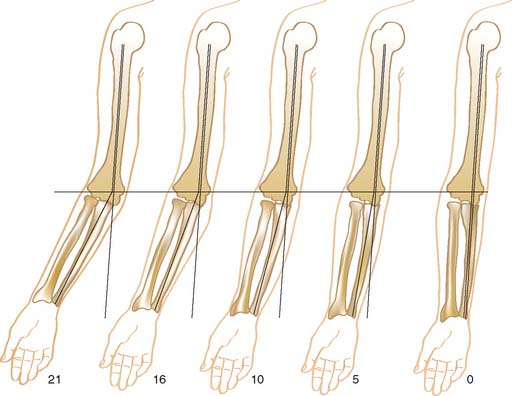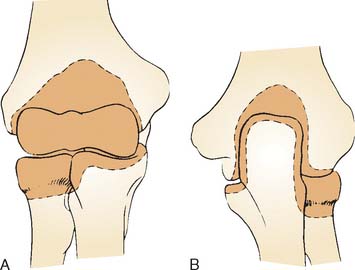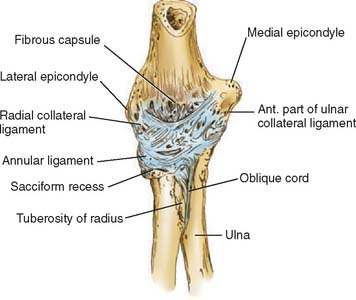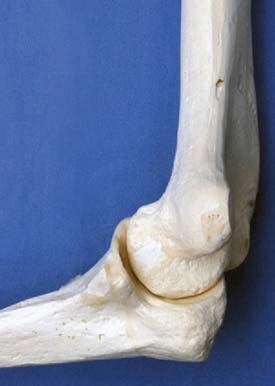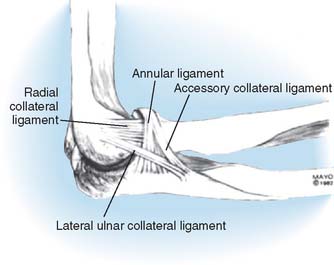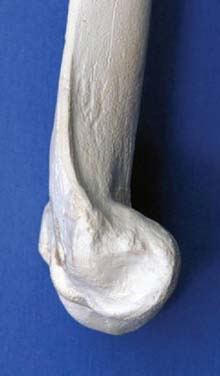CHAPTER 2 Anatomy of the Elbow Joint
This chapter discusses the normal anatomy of the elbow region. Abnormal and surgical anatomy is addressed in subsequent chapters of this book dealing with the pertinent condition.
TOPICAL ANATOMY AND GENERAL SURVEY
The contours of the biceps muscle and antecubital fossa are easily observed anteriorly. Laterally, the avascular interval between the brachioradialis and the triceps, the so-called column, is an important palpable landmark for surgical exposures (Fig. 2-1). Laterally, the tip of the olecranon, the lateral epicondyle, and the radial head also form an equilateral triangle and provide an important landmark for joint aspiration and for elbow arthro-scopy (see Chapters 37 and 77). The flexion crease of the elbow is in line with the medial and lateral epicondyles and thus is actually 1 to 2 cm proximal to the joint line when the elbow is extended (Fig. 2-2). The inverted triangular depression on the anterior aspect of the extremity distal to the epicondyles is called the cubital (or antecubital) fossa.
The superficial cephalic and basilic veins are the most prominent superficial major contributions of the anterior venous system and communicate by way of the median cephalic and median basilic veins to form an “M” pattern over the cubital fossa (Fig. 2-3).
The extensor forearm musculature originates from the lateral epicondyle and was termed the mobile wad by Henry.37 This forms the lateral margin of the antecubital fossa and the lateral contour of the forearm and comprises the brachioradialis and the extensor carpi radialis longus and brevis muscles. The muscles comprising the contour of the medial anterior forearm include the pronator teres, flexor carpi radialis, palmaris longus, and flexor carpi ulnaris. Henry has demonstrated that their relationship and location can be approximated by placing the opposing thumb and the index, long, and ring fingers over the anterior medial forearm. The dorsum of the forearm is contoured by the lateral extensor musculature, consisting of the anconeus, extensor carpi ulnaris, extensor digitorum quinti, and extensor digitorum communis.
Dermal innervation about the proximal elbow is rather variable being provided by the lower lateral cutaneous (C5, C6) and medial cutaneous (radial nerve, C8, T1 and T2) nerves of the arm. The forearm skin is innervated by the medial (C8, T1), lateral (musculocutaneous, C5, C6), and posterior (radial nerve, C6-8) cutaneous nerves of the forearm (Fig. 2-4).
OSTEOLOGY
HUMERUS
The distal humerus consists of an arch formed by two condyles that contain the articular surfaces of the trochlea and capitellum (Fig. 2-5).
In about 90% of individuals,86 a thin membrane of bone separates the olecranon and coronoid fossae (Fig. 2-6). The medial supracondylar column is smaller than the lateral and explains the vulnerability of the medial column to fracture with trauma and some surgical procedures.56 The posterior aspect of the lateral supracondylar column is flat, allowing ease of application of contoured plates (see Chapter 22). The prominent lateral supracondylar ridge serves as attachment for the brachioradialis and extensor carpi radialis longus muscles anteriorly and for the triceps posteriorly. It is also an important landmark for many lateral surgical approaches especially for the “column procedure” (see Chapters 7 and 32).
Proximal to the medial epicondyle, about 5 to 7 cm along the medial intramuscular septum, a supracondylar process is observed in 1% to 3% of individuals45,49,81 (Fig. 2-7). A fibrous band termed the ligament of Strothers may originate from this process and attach to the medial epicondyle.38 When present, this spur serves as an anomalous insertion of the coracobrachialis muscle and an origin of the pronator teres muscle.34 Various pathologic processes have been associated with the supracondylar process, including fracture45 and median4 and ulnar nerve38 entrapment (see Chapter 80).
RADIUS
The radial head defines the proximal radius and articulates with the capitellum. It exhibits a cylindrical shape with a depression in the midportion to accommodate the capitellum. The disc-shaped head is secured to the ulna by the annular ligament (Fig. 2-8). Distal to the radial head, the bone tapers to form the radial neck, which, along with the head, is vulnerable to fracture.83 The radial tuberosity marks the distal aspect of the neck and has two distinct parts. The anterior surface is covered by a bicipitoradial bursa protecting the biceps tendon during full pronation (Fig. 2-9). However, it is the rough posterior aspect that provides the site of attachment of the biceps tendon. During full pronation the tuberosity is in a dorsal position and allows repair of a ruptured biceps tendon through a posterior approach12 (see Chapter 34) and is helpful to determine axial alignment of proximal radial fractures.26
ULNA
The proximal ulna provides the greater sigmoid notch (incisura semilunaris), which serves as the major articulation of the elbow that is responsible for its inherent stability (Fig. 2-10). The cortical surface of the coronoid process serves as the site of insertion of the brachialis muscle and of the oblique cord. Medially the sublime tubercle serves as insertion site of the medial ulnar collateral ligament. The triceps tendon attaches to the posterior aspect of the olecranon process.
On the lateral aspect of the coronoid process, the lesser semilunar or radial notch articulates with the radial head and is oriented roughly perpendicular to the long axis of the bone. Distal to this the supinator crest serves as attachment to the supinator muscle, a tuberosity occurs on this crest, which is the site of insertion of the lateral ulnar collateral ligament.52,56,66
ELBOW JOINT STRUCTURE
ARTICULATION
The elbow joint articulation is classified as a trochoginglymoid joint.77 The ulnohumeral joint resembles a hinge (ginglymus), allowing flexion and extension. The radiohumeral and proximal radioulnar joint allows axial rotation or a pivoting (trochoid) type of motion.
Humerus
The trochlea is the hyperboloid, pulley-like surface that articulates with the semilunar notch of the ulna covered by articular cartilage through an arc of 300 degrees42,73,77 (Fig. 2-11). The medial contour is larger and projects more distally than does the lateral portion of the trochlea (Fig. 2-12). The two surfaces are separated by a groove that courses in a helical manner from an anterolateral to a posteromedial direction.
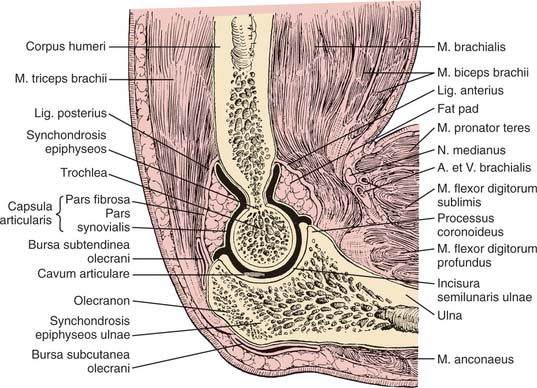
FIGURE 2-11 Sagittal section through the elbow region, demonstrating the high degree of congruity.
(Redrawn from Anson, B. J., and McVay, C. B.: Surgical Anatomy, Vol. 2, 5th ed. Philadelphia, W. B. Saunders Co., 1971.)
In the lateral plane, the orientation of the articular surface of the distal humerus is rotated anteriorly about 30 degrees with respect to the long axis of the humerus (Fig. 2-13). The center of the concentric arc formed by the trochlea and capitellum is on a line that is coplanar to the anterior distal cortex of the humerus.58 In the transverse plane, the articular surface and axis of rotation is rotated inward approximately 5 degrees (Fig. 2-14), and in the frontal plane, it is tilted approximately 6 degrees in valgus43,47,80 (Fig. 2-15).
Proximal Radius
Hyaline cartilage covers the depression of the radial head, which has an angular arc of about 40 degrees,77 as well as approximately 240 degrees of articular cartilage that articulates with the ulna, hence approximately 120 degrees of the radial circumference is not articular and amenable to open reduction internal fixation (ORIF) for fracture16 (Fig. 2-16). The lesser sigmoid fossa forms an arc of approximately 60 to 80 degrees,42,77 leaving an excursion of about 180 degrees for pronation and supination. The anterolateral third of the circumference of the radial head is void of cartilage. This part of the radial head lacks subchondral bone and thus is not as strong as the part that supports the articular cartilage; this part has been demonstrated to be the portion most often fractured.83 The head and neck are not co-linear with the rest of the bone and form an angle of approximately 15 degrees, with the shaft of the radius directed away from the radial tuberosity28 (Fig. 2-17).
Proximal Ulna
In most individuals, a transverse portion of non-articular cartilage divides the greater sigmoid notch into an anterior portion comprising the coronoid and the posterior olecranon (Fig. 2-18).
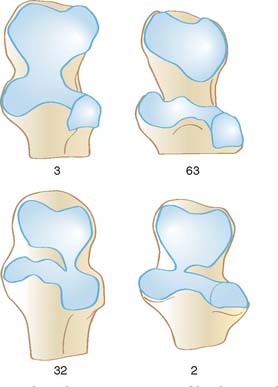
FIGURE 2-18 The relative percentage of hyaline cartilage distribution at the proximal ulna.
(Redrawn from Tillmann, B.: A Contribution to the Function Morphology of Articular Surfaces. Translated by G. Konorza. Stuttgart, George Thieme, Publishers; P. S. G. Publishing Co., Littleton, Mass., 1978.)
In the lateral plane, the sigmoid notch forms an arc of about 190 degrees.74 The contour is not a true hemicircle but rather is elipsoid. This explains the articular void in the midportion.85
The orientation of the articulation is oriented approximately 30 degrees posterior to the long axis of the bone (Fig. 2-19). This matches the 30 degrees anterior angulation of the distal humerus, providing stability in full extension (see Chapter 3). In the frontal plane, the shaft is angulated from about 1 to 6 degrees43,47,73 lateral to the articulation (Fig. 2-20). This angle contributes, in part, to the variation of the carrying angle, which is discussed in Chapter 3.
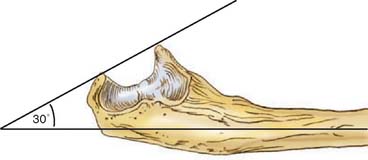
FIGURE 2-19 The greater sigmoid notch opens posteriorly with respect to the long axis of the ulna. This matches the 30-degree anterior rotation of the distal humerus, as shown in Figure 2-13.
CARRYING ANGLE
The so-called carrying angle is the angle formed by the long axes of the humerus and the ulna with the elbow fully extended (Fig. 2-21). In men, the mean carrying angle is 11 to 14 degrees, and in women, it is 13 to 16 degrees.3,43,69 Furthermore, the carrying angle is approximately 1 degree greater in the dominant than nondominant side.88
JOINT CAPSULE
The anterior capsule inserts proximally above the coronoid and radial fossae (Fig. 2-22). Distally, the capsule attaches to the anterior margin of the coronoid medially as well as to the annular ligament laterally. Posteriorly, the capsule attaches just above the olecranon fossa, distally along the supracondylar bony columns. Distally, attachment is along the medial and lateral articular margin of the sigmoid notch. The greatest capacity of the elbow occurs at about 80 degrees of flexion40,70 and is 25 to 30 mL.70
The anterior capsule is normally a thin transparent structure but significant strength is provided by transverse and obliquely directed fibrous bands23,56 (Fig. 2-23). The anterior structure is, of course, taut in extension but becomes lax in flexion. The joint capsule is innervated by highly variable branches from all major nerves crossing the joint, including the contribution from the musculoskeletal nerve (Fig. 2-24).
LIGAMENTS
Medial Collateral Ligament Complex
The medial collateral ligament consists of three parts: anterior, posterior, and transverse segments (Fig. 2-25). The anterior bundle is the most discrete component, the posterior portion being a thickening of the posterior capsule, and is well defined only in about 90 degrees of flexion. The transverse component (ligament of Cooper) appears to contribute little or nothing to elbow stability.
The ligament originates from a broad anteroinferior surface of the epicondyle.65 The ulnar nerve rests on the posterior aspect of the medial epicondyle but is not intimately related to the fibers of the anterior bundle of the medial collateral ligament itself. This has obvious implications with regard to the treatment of ulnar nerve decompression by medial epicondylar ostectomy. A more obliquely oriented excision might be most appropriate to both decompress the ulnar nerve and preserve the collateral ligament origin. On the lateral projection, the origin of the anterior bundle of the medial collateral ligament is precisely at the axis of rotation at the anterior, inferior margins of the medial epicondyle62 (Fig. 2-26). The posterior bundle inserts along the midportion of the medial margin of the semilunar notch. The width of the anterior bundle is approximately 4 to 5 mm compared with 5 to 6 mm at the midportion of the fan-shaped posterior segment.56 Recently ultrasound assessment has proved helpful in further documenting the dimensions of these structures.61
The function of the ligamentous structures is discussed in detail below. Clinically and experimentally, the anterior bundle is clearly the major portion of the medial ligament complex59 and has been divided into anterior, posterior and deep medial subcomponents.62
Lateral Ligament Complex
Unlike the medial collateral ligament complex, with its rather consistent pattern, the lateral ligaments of the elbow joint are less discrete, and individual variation iscommon.30,31,40,75 Our investigation has suggested that several components make up the lateral ligament complex: (1) the radial collateral ligament, (2) the annular ligament, (3) a variably present accessory lateral collateral ligament, and (4) the lateral ulnar collateral ligament. These observations have now been confirmed by others. The current thinking is to consider the complex to be roughly in the shape “Y,” the arms of which attach to the anterior and posterior aspect of the semilunar notch13,72 (Fig. 2-27).
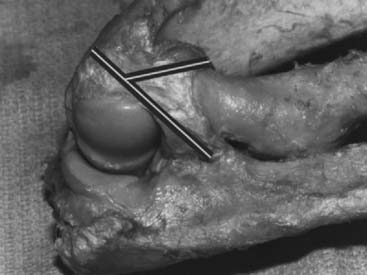
FIGURE 2-27 Dissection demonstrating the “Y” orientation of the lateral collateral ligament complex.
Radial Collateral Ligament
This structure originates from the lateral epicondyle and is actually a complex of several components (Fig. 2-28). Its superficial aspect provides a source of origin for a portion of the supinator muscle. The length averages approximately 20 mm with a width of approximately 8 mm. This portion of the ligament is almost uniformly taut throughout the normal range of flexion and extension, indicating that the origin of the ligament is very near the axis of flexion (Fig. 2-29).
Annular Ligament
A strong band of tissue originating and inserting on the anterior and posterior margins of the lesser sigmoid notch forms the annular ligament and maintains the radial head in contact with the ulna. The ligament is tapered distally to give the shape of a funnel and contributes about four fifths of the fibro-osseous ring.52 The structure is not as simple as it appears because fibers arc medially and laterally to secure the annular ligament to the ulna.72 A synovial reflection extends distal to the lower margin of the annular ligament, forming the sacciform recess. The radial head is not a pure circular disc76; thus, it has been observed that the anterior insertion becomes taut during supination and the posterior aspect becomes taut during extremes of pronation.88
Stay updated, free articles. Join our Telegram channel

Full access? Get Clinical Tree



